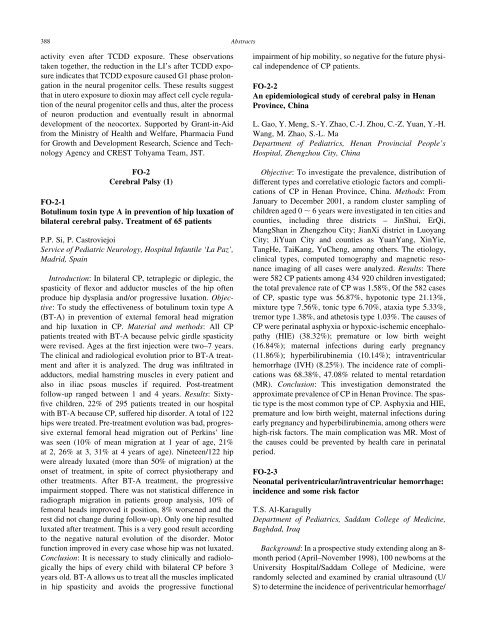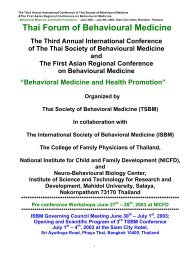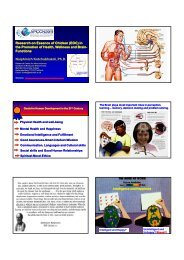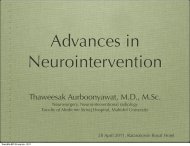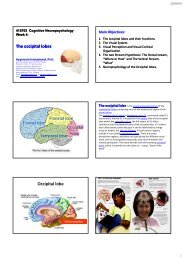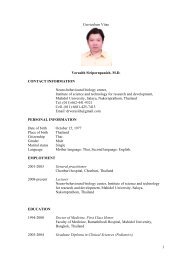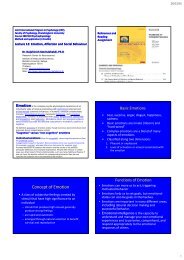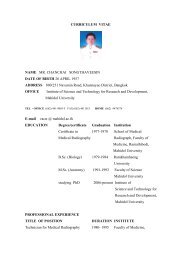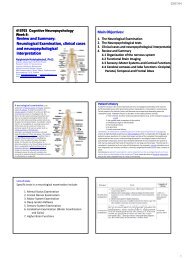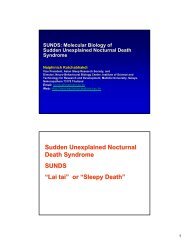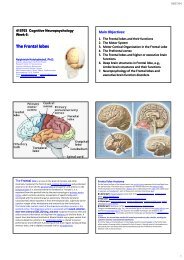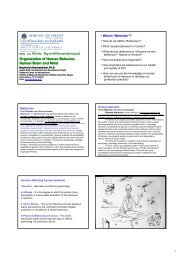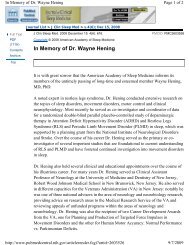PDF File - Mahidol University
PDF File - Mahidol University
PDF File - Mahidol University
Create successful ePaper yourself
Turn your PDF publications into a flip-book with our unique Google optimized e-Paper software.
388<br />
Abstracts<br />
activity even after TCDD exposure. These observations<br />
taken together, the reduction in the LI’s after TCDD exposure<br />
indicates that TCDD exposure caused G1 phase prolongation<br />
in the neural progenitor cells. These results suggest<br />
that in utero exposure to dioxin may affect cell cycle regulation<br />
of the neural progenitor cells and thus, alter the process<br />
of neuron production and eventually result in abnormal<br />
development of the neocortex. Supported by Grant-in-Aid<br />
from the Ministry of Health and Welfare, Pharmacia Fund<br />
for Growth and Development Research, Science and Technology<br />
Agency and CREST Tohyama Team, JST.<br />
FO-2<br />
Cerebral Palsy (1)<br />
FO-2-1<br />
Botulinum toxin type A in prevention of hip luxation of<br />
bilateral cerebral palsy. Treatment of 65 patients<br />
P.P. Si, P. Castroviejoi<br />
Service of Pediatric Neurology, Hospital Infantile ‘La Paz’,<br />
Madrid, Spain<br />
Introduction: In bilateral CP, tetraplegic or diplegic, the<br />
spasticity of flexor and adductor muscles of the hip often<br />
produce hip dysplasia and/or progressive luxation. Objective:<br />
To study the effectiveness of botulinum toxin type A<br />
(BT-A) in prevention of external femoral head migration<br />
and hip luxation in CP. Material and methods: All CP<br />
patients treated with BT-A because pelvic girdle spasticity<br />
were revised. Ages at the first injection were two–7 years.<br />
The clinical and radiological evolution prior to BT-A treatment<br />
and after it is analyzed. The drug was infiltrated in<br />
adductors, medial hamstring muscles in every patient and<br />
also in iliac psoas muscles if required. Post-treatment<br />
follow-up ranged between 1 and 4 years. Results: Sixtyfive<br />
children, 22% of 295 patients treated in our hospital<br />
with BT-A because CP, suffered hip disorder. A total of 122<br />
hips were treated. Pre-treatment evolution was bad, progressive<br />
external femoral head migration out of Perkins’ line<br />
was seen (10% of mean migration at 1 year of age, 21%<br />
at 2, 26% at 3, 31% at 4 years of age). Nineteen/122 hip<br />
were already luxated (more than 50% of migration) at the<br />
onset of treatment, in spite of correct physiotherapy and<br />
other treatments. After BT-A treatment, the progressive<br />
impairment stopped. There was not statistical difference in<br />
radiograph migration in patients group analysis, 10% of<br />
femoral heads improved it position, 8% worsened and the<br />
rest did not change during follow-up). Only one hip resulted<br />
luxated after treatment. This is a very good result according<br />
to the negative natural evolution of the disorder. Motor<br />
function improved in every case whose hip was not luxated.<br />
Conclusion: It is necessary to study clinically and radiologically<br />
the hips of every child with bilateral CP before 3<br />
years old. BT-A allows us to treat all the muscles implicated<br />
in hip spasticity and avoids the progressive functional<br />
impairment of hip mobility, so negative for the future physical<br />
independence of CP patients.<br />
FO-2-2<br />
An epidemiological study of cerebral palsy in Henan<br />
Province, China<br />
L. Gao, Y. Meng, S.-Y. Zhao, C.-J. Zhou, C.-Z. Yuan, Y.-H.<br />
Wang, M. Zhao, S.-L. Ma<br />
Department of Pediatrics, Henan Provincial People’s<br />
Hospital, Zhengzhou City, China<br />
Objective: To investigate the prevalence, distribution of<br />
different types and correlative etiologic factors and complications<br />
of CP in Henan Province, China. Methods: From<br />
January to December 2001, a random cluster sampling of<br />
children aged 0 , 6 years were investigated in ten cities and<br />
counties, including three districts – JinShui, ErQi,<br />
MangShan in Zhengzhou City; JianXi district in Luoyang<br />
City; JiYuan City and counties as YuanYang, XinYie,<br />
TangHe, TaiKang, YuCheng, among others. The etiology,<br />
clinical types, computed tomography and magnetic resonance<br />
imaging of all cases were analyzed. Results: There<br />
were 582 CP patients among 434 920 children investigated;<br />
the total prevalence rate of CP was 1.58%, Of the 582 cases<br />
of CP, spastic type was 56.87%, hypotonic type 21.13%,<br />
mixture type 7.56%, tonic type 6.70%, ataxia type 5.33%,<br />
tremor type 1.38%, and athetosis type 1.03%. The causes of<br />
CP were perinatal asphyxia or hypoxic-ischemic encephalopathy<br />
(HIE) (38.32%); premature or low birth weight<br />
(16.84%); maternal infections during early pregnancy<br />
(11.86%); hyperbilirubinemia (10.14%); intraventricular<br />
hemorrhage (IVH) (8.25%). The incidence rate of complications<br />
was 68.38%, 47.08% related to mental retardation<br />
(MR). Conclusion: This investigation demonstrated the<br />
approximate prevalence of CP in Henan Province. The spastic<br />
type is the most common type of CP. Asphyxia and HIE,<br />
premature and low birth weight, maternal infections during<br />
early pregnancy and hyperbilirubinemia, among others were<br />
high-risk factors. The main complication was MR. Most of<br />
the causes could be prevented by health care in perinatal<br />
period.<br />
FO-2-3<br />
Neonatal periventricular/intraventricular hemorrhage:<br />
incidence and some risk factor<br />
T.S. Al-Karagully<br />
Department of Pediatrics, Saddam College of Medicine,<br />
Baghdad, Iraq<br />
Background: In a prospective study extending along an 8-<br />
month period (April–November 1998), 100 newborns at the<br />
<strong>University</strong> Hospital/Saddam College of Medicine, were<br />
randomly selected and examined by cranial ultrasound (U/<br />
S) to determine the incidence of periventricular hemorrhage/


